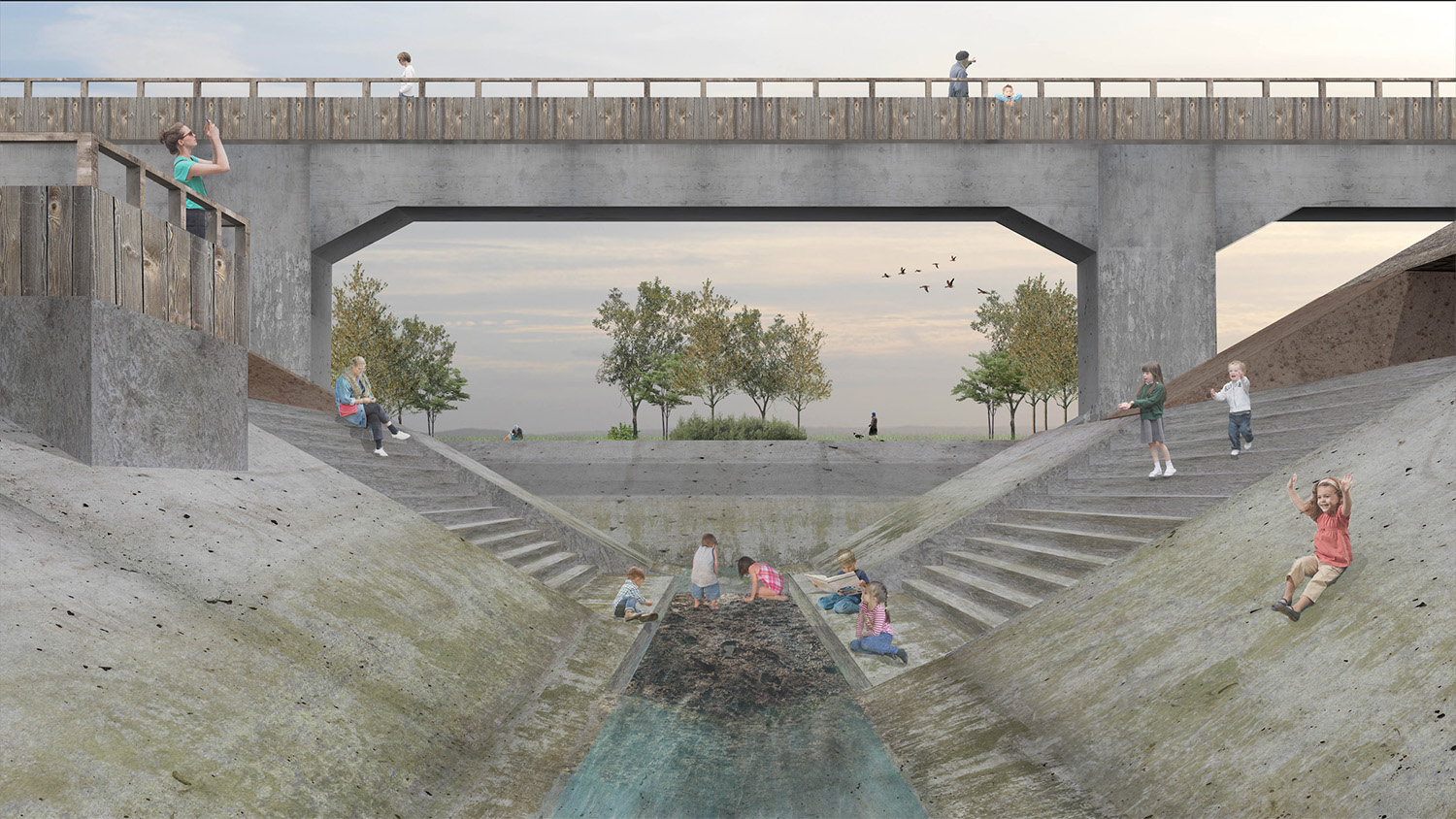With Degree Show season now at a close, we look back at our students’ final projects and the inspirations behind them.
“I wish our classroom could be on the beach.”
The concept of the maritime is etched into the fabric of Canvey Island – a civil parish and reclaimed island in the Thames estuary in Essex. Sailing and yacht clubs, marina workshops and the iconic Chapman Lighthouse are still significant factors in the identity of Canvey today. Traditional nautical themes still resonate around the island, yet over the years, its impact has diminished and is now fading into obscurity. BA Architecture student Amar Sall’s final project Marina-Ville proposes to change that.
His project brings together two disparate, distanced generations, with a masterplan to regenerate the Marina environment and revive a forgotten community. Sall imagines island seniors helping share knowledge of craft and history, through construction and archiving, teaching new skills to engaged youths. In turn, youths will help maintain the area, through the management and development of new skills, helping preserve the “reviving” maritime tradition. With the introduction of several spaces and using submersible structures to link the land and sea, Marina-Ville will address making and learning within a natural and artificial landscape. The project was recently awarded one of five prizes as part of the inaugural Maison/0 Green Trail and was also shortlisted for the 2018 Spatial Practices Prizes. Here, Sall talks us through five areas of his practice that have helped him in the development of Marina-Ville – five factors that he believes are the most important in the field of architecture.

Canvey Conversations, a Tile-Making Engagement on Canvey Island Beach, 2017
1. Engagement
Engagement is the foundation of crucial research. Being truly immersed in a community provides the ultimate platform for ideas. First hand interaction with users allows for conversations which create a richness in the development of concepts; no project should begin without a form of user-engagement. For this proposal, my team and I produced activities on site for specific age groups. These took the form of tile-making exercises on the beach for children, extracting the educational potential from the landscape, and a pub quiz for the seniors of the site, allowing for a more social and informal interaction. These activities were devised to gauge local issues and potentials. Direct communication with the users is, without question, a key aspect of progression within this practice.

Amar Sall, Issues and Potentials of Oyster Creek and Small-Gains Marina, 2017
2. Narrative
The art of storytelling is one of the most open forms of communication used today – in practice, it is no different. In particular, a cohesive scenario spanning the breadth of a project is the best way to communicate and enhance the viability and integrity of the work. Narrative helps target a point of view and acts as a guide through a project. In particular, Marina-Ville developed through the narratives exposed by local users, who provided issues and potentials related to the site on Canvey Island. Using the marina as a starting point, I investigated how the development and state of the area had impacted on local residents and what could be positively extracted. Heritage, tradition, opportunity and ambition were all results of advancing the narrative in tandem with my previous engagement – establishing a narrative of development through redevelopment.

Amar Sall, Material Tidal Pool Totem, constructed from Concrete Alternatives for a more sustainable outcome, 2018
3. Materials
With a rise in sea levels and the impact of humans on the planet, it is imperative that decisions are made with materiality and composition in mind. Experimentation through materials provides an open opportunity for extracting the greatest potential for a more sustainable outcome. Marina-Ville was developed through testing and experimenting with alternatives to concrete, using hybrid aggregates to reduce a pollutant footprint. These experiments utilised natural materials that could be extracted from the local building site. Through testing, we reached an outcome in the form of a material totem – in particular, a miniature tidal pool. Using concrete alternatives such as hybrids with clay, brick, latex, grass, mud and more natural elements, allowed me to understand the structural potential of these creations and input them into the final design. Materials enforce the language of the building.

Amar Sall, Marina-Ville, a slice of the masterplan, 2018
4. Design
The experimentation, the narrative and the research all formulates into one final design. A design can never be truly finished, there will always be room for it to grow. Marina-Ville’s design was consolidated through material testing, narrative development and in particular, the reconfiguration of the landscape. Designing a building has its own sets of challenges, however, as Marina-Ville sits on its own developed landscape, this aided theoretical design choices of the overall masterplan: To provide a seamless connection between the land and buildings and to combine the structure and programme of the proposal itself, providing a relationship to create and expand on in practice.

Amar Sall, Cross-Generational Marina Workshop Interior, 2018
5. Experience
How does it feel to be in the proposal? Can you place yourself inside the idea? Once the design is in place, and it is about the experience, does the narrative still maintain its strength? Is this what was originally set out? The final design should retain all the elements of its development, while fitting within the context of the site and remaining suitable in its own narrative. Creating a rich experience can often be the make or break point of a project and without experience there can be no solid project at all. Architects often use the idea of “the experience” to create moments that can develop the project further, through the creation of the right atmosphere and environment. These moments highlight the true potential that was set out in the start, proving that the final design itself is not only conceptually effective, but practically effective too.
More:
- Read about BA Architecture
- Read about Maison/0

